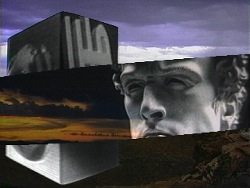Woody Vasulka
Biography
Woody Vasulka's work in video focused on a rich articulation of the syntactical potential of electronic imaging. After producing a pioneering body of work in collaboration with Steina in the early 1970s, he undertook a sophisticated exploration of the narrative and metaphorical meaning of technological images. Vasulka's development of an expressive image-language evolved from a rigorous deconstruction of the materiality of the electronic signal, through experiments with new technologies of digital manipulation, to the application of these imaging codes to narrative strategies.
The culmination of this investigation, Art of Memory (1987), is one of the major works in video. In this lushly textured, haunting essay, Vasulka applied a highly evolved imaging grammar to a metaphorical discourse of collective memory, history, and the meaning of recorded images — envisioned as a spectacular memory-theater inscribed upon the landscape of the American Southwest.
In his early investigations of the vocabulary of such devices as the Digital Image Articulator, Vasulka emphasized the dialogue between artist and machine, as manifested in real-time creativity and process-oriented experimentation. Through digital manipulation, he continues to explore the malleability and objectification of the electronic image as a means of rendering a complex inventory of rhetorical devices. With the fantastical "electronic opera" The Commission (1983), Vasulka began to apply these codes to the development of narrative and metaphorical strategies, an inquiry that dominated his later work. Woody Vasulka was born in Brno, Czechoslovakia in 1937 and died in 2019. He studied at the School of Industrial Engineering in Brno and the Academy of Performing Arts Faculty of Film and Television in Prague. With Steina, he has won numerous awards and grants; their collaborative works have been exhibited internationally (see Steina and Woody Vasulka). His individual works have been shown in numerous exhibitions, at festivals and institutions including the International Center of Photography, New York; Los Angeles Contemporary Exhibitions (LACE); Carnegie Museum of Art, Pittsburgh; and the Whitney Museum of American Art Biennial, New York. He lived in Santa Fe, New Mexico until his death in 2019.
